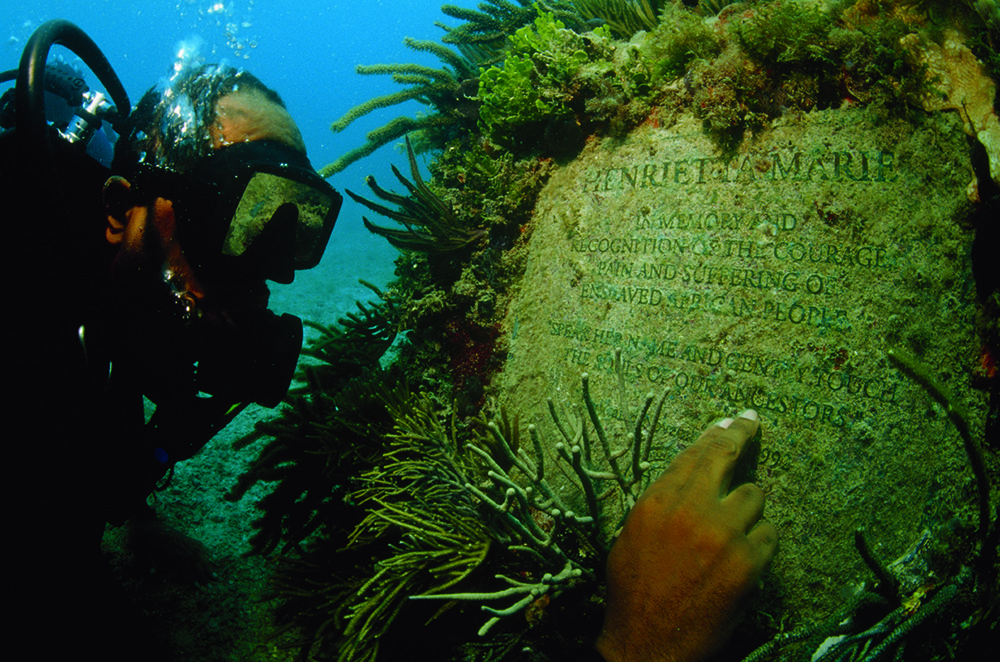Shackles From the Deep takes an innovative approach to explaining the slave trade

In his new book, Shackles From the Deep, journalist and scuba diver Michael Cottman explores the history of the slave trade by focusing on the journey of a single ship: the Henrietta Marie. By integrating the story of one slave ship with his own journey of discovery, Cottman humanizes the slave trade for young readers. He transforms the passive way slavery is traditionally taught into an active approach centered on curiosity and discovery.
We had a chance to speak with Cottman before he began his book tour this month. He talked about his journey in writing the book, the importance of developing a passion, and the unprecedented partnership that made the discovery possible.
Cottman’s journey started with his own desire to learn more about the Henrietta Marie, a British slave ship that sank in the Florida Straits in 1700. Like many colonial slave ships, the Henrietta Marie took part in the “Triangle Trade,” transporting slaves from West Africa to the Americas, raw materials (such as sugar or tobacco) from the Americas to Great Britain, and finally supplies and manufactured goods to British outposts in Africa. The ship had just completed a journey to Jamaica to deliver slaves when it was hit by a hurricane on its return voyage to London. The crew perished, and though there were no slaves on board, the shackles and chains that had held them sank to the ocean floor. Marine archaeologists discovered the shackles in 1972 and the ship’s bell in 1983.
In 1994, Cottman decided he wanted to “retrace the Henrietta Marie’s steps” himself. As an avid scuba diver, he was in the perfect position to do so.
International Business of Slavery
As Cottman researched the Henrietta Marie by reading historic records, he became “overwhelmed with the fact that Africans were characterized as ‘cargo’ or ‘beasts,’ and never as humans.”
While admitting how emotionally difficult the journey was, Cottman was driven by his passion to understand the history of his ancestors. He hopes the emotional aspect of his journey sends a message to young people about how important it is to develop a passion—to “wake up excited and find something you care deeply about.”
Cottman explained that his work piecing together the history of the Henrietta Marie was also driven by a need for closure. He desperately wanted to gain an understanding of what motivated the everyday people involved in carrying out the slave trade.
Through careful research, Cottman discovered the name of the British ironmonger responsible for crafting the shackles discovered with the wreck of the Henrietta Marie: Anthony Tournay. Looking at the motives of people like Tournay reveals that the slave trade was made up of ordinary men and women, capable of compassion in other circumstances, who were participating in what Cottman reminds us was “the international business of slavery.”
Excavating the Henrietta Marie
Excavating the wreck of the Henrietta Marie led to the recovery of over 22,000 artifacts. As Cottman notes, the Henrietta Marie is “believed to be the world’s largest source of tangible objects representing the early years of the African slave trade.” Some of the recovered items include glass beads, which were used “to barter for African people who would be traded into slavery,” and an encrusted cauldron used for cooking.
The excavation of the wreck, as well as the creation of an underwater memorial plaque at the site, were carried out by members of the National Association of Black Scuba Divers and the predominantly white Maritime Heritage Society. The success of this partnership is what Cottman considers the biggest take-away of Shackles From the Deep.
Cottman expresses his hope that readers walk away with an appreciation for “the power of different ethnic or racial groups to work together for a common purpose.” While in this case the common purpose was the excavation of a shipwreck, Cottman reminds readers that there are “many other purposes to come together on.” He emphasized that doing so requires “people interacting with people who don’t look like them, which is especially important in our expanding multicultural society.”
Shackles From the Deep “is part detective, part mystery, part underwater exploration, and part personal journey,” according to Cottman, in which the “byproduct is learning about the slave trade.”
Engaging students in a story about a shipwreck and underwater exploration lets the topic of the slave trade be presented in a dynamic way rather than what Cottman refers to as “the boring paperwork” approach that often overwhelms students. He concludes that “we were learning about and making history”, sending the critical message that history is a ongoing process that students can participate in. and many more